On this page:
What are car parking lots
Car parking lots are open areas of land used for parking cars.
They can be publicly or privately owned and are generally located in activity centres, at train and bus stations, and other facilities accessed by car. Some higher density residential developments may incorporate private car parking lots.
While many car parking lots are open to pedestrian access, dedicated pedestrian paths are not common. Bicycle movement through car parking lots is generally restricted or not permitted.
At times, car parking lots may be used for other purposes, such as a market, or for entertainment or sports activities.
Why is it important?
Car parking lots are important for the convenience of drivers and the viability of some businesses, and in activity centres they provide space for customer parking away from neighbouring residential streets.
Where land is freely available and land values are relatively low, car parking lots are often the least costly method of providing parking in urban areas.
Car parking lots should be convenient, pleasant and safe for users. As they occupy large areas of land they should be designed not to create barriers for pedestrians.
Measures should be taken to minimise the impact of paved surfaces in radiating heat in summer and generating stormwater run–off.
After hours and during low demand periods, car parking lots should be managed to ensure they do not attract anti–social behaviour and are safe for users.
2.8.1: ensure that car parking lots support the amenity and safety of the local area
- Locate larger car parking lots to the rear or side of the buildings they serve.
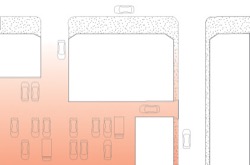
Tip: locating larger car parking lots between the street and the building frontage may reduce street amenity and compromise pedestrian access to buildings. - Provide car parking lots with opportunities to receive informal surveillance from surrounding buildings and spaces.
Tip: car parking lots bordered by blank walls or fences enclose the area and reduce the opportunity for informal surveillance.
- Where a car parking lot must be located between the building frontage and the street, arrange the parking space to maintain a visual connection between the building and the street.
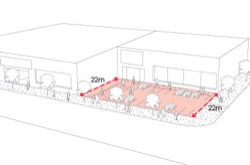
Tip: a 22 m setback allows for two rows of 90 degree parking with single vehicle access way between, landscaping along the street edge and pedestrian paths serving the parking. A setback of up to 22 m will maintain a visual connection from the building to the street, whereas greater distances can compromise visual connection. - Where a car parking lot must be located between the building frontage and the street, arrange the site to allow for future development options.
- Lay out car parking lots to minimise noise, fumes and lighting impacts into adjacent properties.
2.8.2: ensure safe and convenient movement for pedestrians and vehicles in car parking lots
Pedestrians will look for the most direct route to their destination. This preferred direct route, called a desire–line, may cross vehicle lanes and garden beds, putting pedestrians at risk and damaging landscaping.
- In large car parking lots, position dedicated direct paths to take pedestrians from car parking spaces to main building entries.
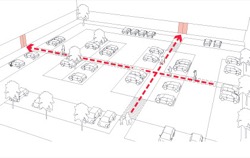
Tip: if a car park lies between the building entrance and the street, people need a convenient path from the street to the building entrance. - Locate pedestrian paths as close as possible to anticipated pedestrian desire–lines.
Tip: when direct pedestrian desire–lines are not taken into account, people make their own informal direct path.
- In large, busy car parking lots, orient the parking aisles perpendicular (90°) to the building entrance or other pedestrian destinations.
- Arrange parking spaces to provide effective sightlines for drivers when turning and reversing.
- Provide clear sightlines at entries and exits to car parking lots.
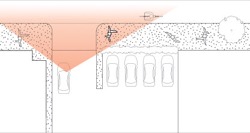
2.8.3: enhance the amenity and safety for pedestrians and drivers in car parking lots
- Provide pedestrian lighting in car parking lots that are used regularly at night.
Tip: avoid unwanted light spill onto adjacent properties. - Locate trees clear of lighting to allow direct illumination of paths and vehicle lanes.

- Provide for vehicle overhang areas to be clear of pedestrian paths, trees or shrubs.
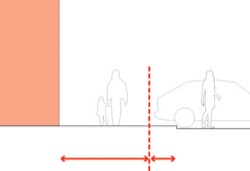
Tip: pedestrian paths may need extra width to allow for overhang from car bonnets or bumper bars. The normal vehicle overhang allowance is 1 m. - Construct a permanent kerb for wheel stops.
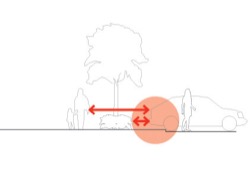
Tip: wheel stops constructed of logs, or kerbs fixed to the pavement with spikes may dislodge under the vehicle causing damage and may also pose a pedestrian trip hazard.
2.8.4: ensure car parking lots are safe and well maintained
- Where the risk of damage from vehicles and vandalism is high, protect vegetation for up to four years from planting.
Tip: vegetation can be protected using tree guards, fencing and level changes.
- Encourage alternative uses for car parking lots during no or low demand periods.
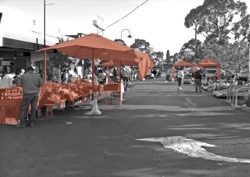
Tip: take advantage of differing periods of demand for car parks by encouraging community activities such as markets and festivals.
2.8.5: maximise the environmental performance of car parking lots
- Provide shade to parking spaces and pedestrian paths.
Tip: a tree canopy or a shade structure may be used.
- Landscape a minimum of 15 per cent of the car parking surface area.
Tip: larger planting areas with a minimum dimension of 2.5 m support tree growth. Small planting areas or narrow strips do not provide sustainable planting conditions.
- Provide for water harvesting and other on–site water re–use and treatment systems.
Tip: water harvesting can provide additional water to plants.
Page last updated: 28/10/25